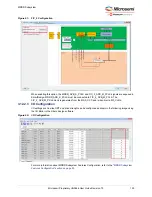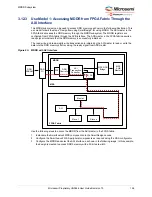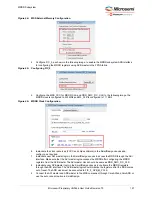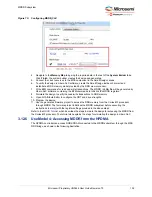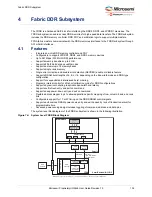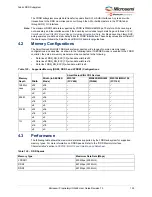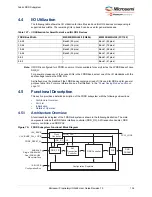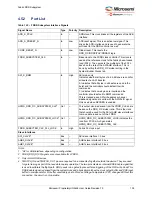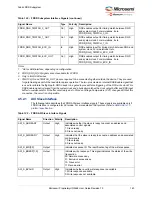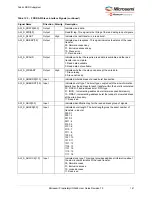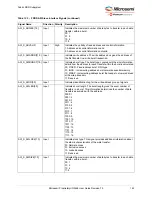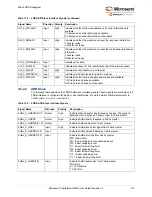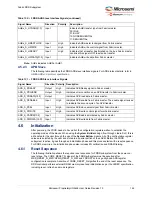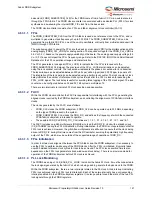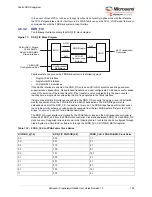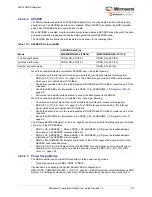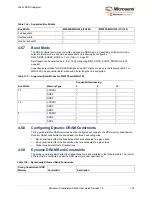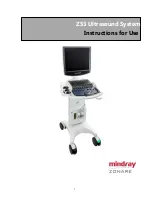
Fabric DDR Subsystem
Microsemi ProprietaryUG0446 User Guide Revision 7.0
139
APB_SLAVE
Bus
–
APB slave interface 3.0 bus
DRAM Interface
FDDR_CAS_N
Out
Low
DRAM CASN
FDDR_CKE
Out
High
DRAM CKE
FDDR_CLK
Out
–
DRAM single-ended clock – for differential pads
FDDR_CLK_N
Out
–
DRAM single-ended clock – for differential pads
FDDR_CS_N
Out
Low
DRAM CSN
FDDR_ODT
Out
High
DRAM ODT.
0: Termination Off
1: Termination On
FDDR_RAS_N
Out
Low
DRAM RASN
FDDR_ RESET_N
Out
Low
DRAM reset for DDR3
FDDR_WE_N
Out
Low
DRAM WEN
FDDR_ADDR[15:0]
Out
–
Dram address bits
FDDR_BA[2:0]
Out
–
Dram bank address
FDDR_DM_RDQS[3:0]
In/out
–
DRAM data mask – from bidirectional pads
FDDR_DQS[3:0]
In/out
–
DRAM single-ended data strobe output – for
bidirectional pads
FDDR_DQS_N[3:0]
In/out
–
DRAM single-ended data strobe output – for
bidirectional pads
FDDR_DQ[31:0]
In/out
–
DRAM data input or output – for bidirectional pads
FDDR_DQ_ECC[3:0]
In/out
–
DRAM data input or output for SECDED
FDDR_DM_RDQS_ECC
In/out
High
DRAM single-ended data strobe output – for
bidirectional pads
FDDR_DQS_ECC
In/out
High
DRAM single-ended data strobe output – for
bidirectional pads
FDDR_DQS_ECC_N
In/out
Low
DRAM data input or output – for bidirectional pads
FDDR_DQS_TMATCH_0_IN
In
High
DQS enables input for timing match between DQS and
system clock. For simulations, tie to
FDDR_DQS_TMATCH_0_OUT.
FDDR_DQS_TMATCH_1_IN
In
High
DQS enables input for timing match between DQS and
system clock. For simulations, tie to
FDDR_DQS_TMATCH_1_OUT.
Table 128 •
FDDR Subsystem Interface Signals
(continued)
Signal Name
Type
Polarity Description
Notes:
1. *AXI or AHB interface, depending on configuration.
2. FDDR_DQS_N[3:0] signals are not available for LPDDR.
3. Only in IGLOO2 Devices.
4. TMATCH_IN and TMATCH_OUT pins are required to be connected together outside the device. They are used
for gate training as part of the read data capture operation. The two pins create an internal DQS Enable signal that
is used to calibrate the flight path. DQS needs to be gated to prevent false triggering of the FIFO write clock.This
DQS Enable signal is derived from the system clock and physically matches the clock output buffer and DQS input
buffer to compensate for I/O buffer uncertainty due to Process-Voltage-Temperature (PVT) changes. Without this
connection, the circuit is not operable.

